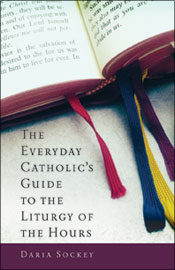Let me admit up front that when it comes to the book The Everyday Catholic's Guide to the Liturgy of the Hours by my friend and fellow Catholic author Daria Sockey, I'm not objective. I loved the book from the moment I saw it. And as a contributor to the book's Introduction, I had a sneak peek while it was in the works. As someone who's struggled to incorporate praying the Hours into a busy mom's life, I was attracted to Daria's realistic, gentle and encouraging approach to this amazing devotion. Today, I'm thrilled to share my recent conversation with Daria Sockey.
Q: Please briefly introduce yourself and your family to our readers.
I'm a Catholic Mom—of seven children. A Catholic Grandmom—of two. I live in northwestern Pennsylvania in a century-old farmhouse with my husband, Bill, and the 3.5 kids who are still at home. (the .5 refers to the one who is away at college most of the year.) Bill has worked for a variety of Catholic organizations, and currently works or the World Apostolate of Fatima. We just celebrated our 33rd wedding anniversary. I've been writing for years for a number of publications, and back in the 80s wrote some of the student texts for the Faith & Life catechisms. But I consider this my first “real” book, since the catechisms were done under the direction of an editor.
Q: What prompted you to write The Everyday Catholic's Guide to the Liturgy of the Hours? How would you describe this book to our readers?
Every journalist wants to write a book eventually. When I finally had the time to do this, I wasn't sure what to write about—it seemed that for every popular Catholic topic there were scores of well-done books out there. But then I realized that there weren't many books written for lay people about the Liturgy of the Hours. I'd been praying the hours for years, and loved it. I also realized that many people found the LOTH to be intimidating, either in terms of figuring out how to use a breviary or how to fit this kind of prayer into their schedules. Furthermore, lots of Catholics don't even know what it is, and that is a problem that just had to be fixed! The Church has been begging us lay folks to give this a try for a long, long time, longing for it to become the prayer of the whole people of God, but that really hasn't happened. I'm hoping my book will help get the word out about this hidden treasure of scriptural prayer.
The book's title explains it all. It's a guide for ordinary people who are interested in what the LOTH is, why they might want to learn this prayer, what resources—print and digital—are available. and for those who already pray the LOTH, there is material that will help them to get more out of it, and maybe reignite their enthusiasm.
Q: What is your personal history with praying the Hours and how did the writing of this book impact your prayer life?
Although I'd participated in a vespers service a couple of times while I was a teen, it didn't make an impact on me. I didn't really know what it was all about. But then in junior year of college I went on a summer semester abroad. Our chaplain led Compline (Night Prayer) in the chapel every night, and aggressively encouraged us to attend. So I tried it and really fell in love with these “bed time” psalms and antiphons which are among the most beautiful and consoling prayers in the liturgy. Phrases like “my soul waits for the Lord more than sentinels wait for the dawn” and “Into your hands Lord,I commend my spirit” and “Protect us Lord as we stay awake, watch over us as we sleep, that awake we may keep watch with Christ and asleep rest in His peace.” I was struck at how these words were perfect expressions of trust and confidence—such a great way to end the day. This led me to make Night Prayer a personal habit, and later, to get a breviary and add Morning and Evening Prayer as well. Later, I also added the Office of Readings, and finally, Daytime Prayer. Now, don't think that all through the years of raising babies, homeschooling, and all the busyness of a mother's life that I faithfully did every liturgical hour of every single day. Far from it. For years I was doing well if I did only one or two of them per day. There were often stretches of weeks at a time when I got away from it entirely. But it was always something I kept coming back to. No other form of prayer has worked better for me. Now that my kids are older it's pretty easy for me to take five liturgical prayer breaks daily. And it's funny, writing my blog and book about the Liturgy of the Hours certainly cemented that faithfulness because now it was on my mind so much of the time during the writing process.
Q: Did you learn anything new in the writing process?
I finally got straight in my mind some of the more obscure rules for which prayers one chooses for the various feast days, memorials, and optional memorials. Also, since I had to do a chapter on resources, I was really glad to become familiar with all the online resources—digital breviaries and tutorials—that are out there. The computer age has been one of mixed blessings, but one really monumental result has been the way the Internet has made the Liturgy of the Hours accessible to everyone.
Overall, it brought my awareness of the benefits of liturgical prayer to a higher level, two things especially: the way it connects us to the universal Church at prayer, and the intimacy with Jesus that it brings, since the psalms are the prayers He prayed while on earth, and continues to pray in, with, and through us as members of His mystical body.
Q: For people who think they are too busy to pray the hours - how would you encourage them and where should they get started?
I'd say to start small, with just one of the hours (or at the most, two) daily. Be faithful to that, and once that is a firm and loved habit, only then discern whether you should try adding more. Night prayer is the easiest to do using a print breviary, so unless you are just too tired to pray well at night I would start there. On the other hand, if you are that classic “morning person” who loves to be up ahead of the rest of your family, then Morning Prayer might be a good starting point for you. If you are a heavily scheduled person, or are just kind of scatter brained like me, then right away do whatever it is you normally do to remind yourself about important things: calendar, day planner, chimes on your mobile device, sticky notes over the kitchen sink, whatever it is that helps you to remember. Also, it might help to link prayer to some activity you always do: just before or after a meal; just before or after a favorite TV program; just before or after you read the daily newspaper. Whatever it is that you wouldn't dream of NOT doing each day, link prayer time to that.
One more thing: podcasts of the liturgical hours at divineoffice.org can be a godsend to moms with small children and babies, or to moms with a long commute to and from work each day. You can listen and pray along while your hands and eyes are occupied.
Q: When you have a week where you are feeling busy and overwhelmed by life, how does your prayer of the Divine Office bring solace and comfort?
In so many ways! For one thing, the psalms speak to every state of the human condition: joy, sorrow, gratitude, fear, stress. So very often the psalms of the day seem to speak to my problems, and remind me that despite my difficulties, trust and hope are the answer.
On the other hand, this kind of prayer simultaneously reminds me that it's not just about me and my problems. The whole Church needs prayers and liturgical prayer unites you to the joys and the sorrows of your brothers and sisters worldwide. You are forced to get beyond your own problems to lift up everyone in prayer. And you are reminded that despite temporary stressors, there is always something to be thankful for: creation, redemption, forgiveness of our sins, salvation.
Most of all, stopping in my tracks five times daily prayer forces me off that hamster wheel of activity, into a space of peace and rest.
Copyright 2013 Lisa M. Hendey
About the Author

Lisa M. Hendey
Lisa M. Hendey is the founder of CatholicMom.com, a bestselling author and an international speaker. A frequent radio and television guest, Hendey travels internationally giving workshops on faith, family, and communications. Visit Lisa at LisaHendey.com, on her Substack at LisaHendey.Substack.com, or on social media @LisaHendey for information on her speaking schedule or to invite her to visit your group, parish, school or organization. Find Lisa’s books on her Amazon author page.





.png?width=1806&height=731&name=CatholicMom_hcfm_logo1_pos_871c_2728c%20(002).png)
Comments